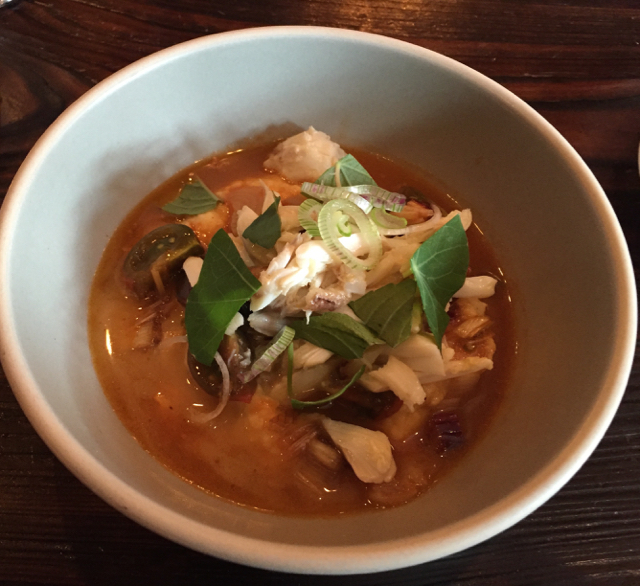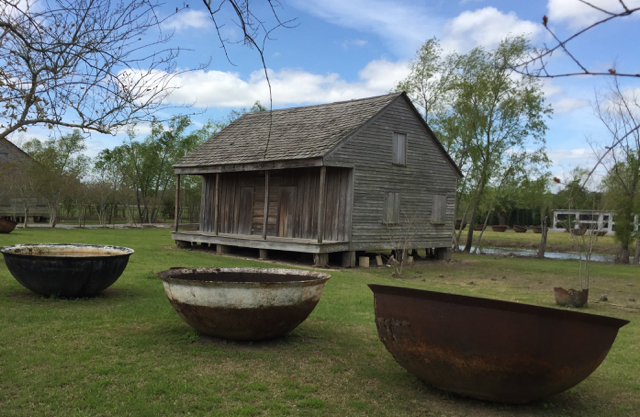After a stunningly good meal at Cochon in New Orleans on Monday, we would have settled for just plain "good" meals on our remaining two days. But the Crescent City -- or Big Easy, if you prefer -- is full of surprises, and we weren't close to done with mouth music in a city that takes as much pride in its food as it does in its jazz.
Speaking of jazz, because we had reservations in the French Quarter for Preservation Hall that evening, we caught an early (5:30) reservation on Magazine Street at Coquette, a bistro in an area of shops and restaurants in the city's Garden District. With our friends Rob and Marcy, we were able to order small plates to share and a few we each coveted and kept pretty much to ourselves. The fried chicken were plump thighs crisply breaded and sliced on the bias so that each resembled the ubiquitous chicken "tenders" you might find at a pub restaurant. The crisp coating included a dash of paprika that spiced them up, but ever so discreetly. Marcy and Rob ordered a plate of sliced cobia, a delicate white fish cured in coffee. But the star for me was a bowl that included flakes of crabmeat set atop a corn pudding and sprinkled with fresh green onion slices and mushrooms. The crabmeat was fresh and perfectly briny, the corn pudding lush, almost like corn grits without the grit, the tastes intense and delicate all at once. A "coquette" is a woman who flirts to win attention and admiration. This Coquette earned both from our four diners. Crab set atop a corn pudding at Coquette in New Orleans.
Crab set atop a corn pudding at Coquette in New Orleans.
Late on Wednesday morning, we drove an hour outside of town to visit the Whitney Plantation, a former sugar cane plantation that has been developed into a living museum by a wealthy New Orleans attorney who believed it could serve as testimony for the stories of the slaves who lived there. Most of those stories are heart rending and all are interesting, an honest portrayal of an ugly period of our nation's history that we should never forget. We were slated to go to a jazz club in the French Quarter that evening, and we decided to have a late lunch/early dinner, again on Magazine Street, at one of the hottest restaurants in town, Alon Shaya's eponymous Shaya. Call it Israeli food with a twist, with influences from throughout the Mediterranean, including Turkey and Greece. Indeed, the bottle of Greek Assyrtiko white wine was the right choice as accompaniment to the assertive dishes we ordered. The pita breads were made in an oven within eyeshot of our table, and they were beautiful balloons of light yet chewy dough and excellent vessels for the small dishes of "salatim," cold dishes served as a single course. All were intensely flavored and colored, most of all the lutenitsa, which the menu described as a “Bulgarian puree of roasted red pepper, eggplant, garlic and tomato.” The paddlefish caviar purée, called ikra, was pale in color compared with the lutenitsa, but not in taste, assertive in a salty and briny way. Taboulleh, not typically one of my favorite dishes, is all about the parsley, and this bunch tasted as if it had just been plucked from the garden. The lamb kebabs were fat cigars of ground, seasoned lamb set amidst that same lutenitsa from the appetizers, but which had the added snap of sesame seeds. Halloumi is a firm Cypriot cheese that shows up on many Mediterranean appetizer menus and is typically fried. The halloumi at Shaya was set atop caramelized celery root puree. The greens that shared the plate added color if not competing tastes. Frankly, the puree was the star of the dish. The three falafels on the "Falafel Plate" were set on a bed of crisp cabbage slivers and were a bright green color inside, tasting of a combination of mint, parsley and cilantro, raising the tasty fried balls to a new level of color and taste.
Shaya's balance of favors were just right in every dish, and we left the restaurant late in the afternoon understanding why everyone we had met earlier in the week had urged us to go there. It certainly is not indigenous New Orleans or Cajun cuisine, but when we look back on our dining experiences in the Big Easy, we won’t forget Shaya. The production of sugar at Whitney Plantation, one hour west of New Orleans, was a round-the-clock-operation tended by some of the plantation's 300 slaves. The dozens of sugar cauldrons at Whitney Plantation form the largest collection in the state of Louisiana.
The production of sugar at Whitney Plantation, one hour west of New Orleans, was a round-the-clock-operation tended by some of the plantation's 300 slaves. The dozens of sugar cauldrons at Whitney Plantation form the largest collection in the state of Louisiana.



